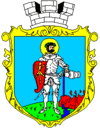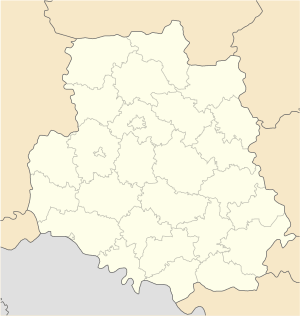Sharhorod
Sharhorod (Ukrainian: Шаргород; Russian: Шаргород, Polish: Szarogród), also known as Shargorod, is a town in Vinnytsia Oblast, Ukraine. It serves as the administrative center of Sharhorod Raion, one of 33 regions of Vinnytsia Oblast. Population: 6,987 (2015 est.)[1]
Sharhorod | |
|---|---|
 Immaculate Conception Church in Sharhorod | |
 Coat of arms | |
 Sharhorod Location of Pohrebyshche  Sharhorod Sharhorod (Ukraine) | |
| Coordinates: 48°45′N 28°5′E | |
| Country Oblast Raion | Vinnytsia Oblast Sharhorod Raion |
| Founded | 1579 |
| Population (2015)[1] | |
| • Total | 6,987 |
History
Early history
Sharhorod was founded in 1579 by Polish-Lithuanian Commonwealth chancellor and hetman, Jan Zamoyski. It was located very close to the border with the Ottoman Empire.
Sharhorod was established as a city under Magdeburg law in 1588.[2]
In the seventeenth century, because of its location along wine and cattle trading routes, Sharhorod emerged as one of the largest towns in Podolia. The Turks occupied Sharhorod between 1672 and 1699, when the town was called "Little Istanbul". During that time the synagogue was converted into a mosque. In the nineteenth century, the town became a center of Jewish Hasidism.[3]
Rabbi Jacob Joseph of Polonne fled to Raşcov as a result of being exiled from Sharhorod. Having been the rabbi of Sharhorod for several years, Rabbi Jacob Joseph was expelled from his position on a Friday afternoon in 1748. In several of his responsa, which he wrote in Raşcov, he reveals the suffering which he had undergone.[4] He would later leave Raşcov after being appointed rabbi in Nemirov, a center of Hasidism, where he practiced daily fasting for five years, until the Besht came upon him.
Sharhorod was briefly described in a book titled: "Geographic Dictionary of Polish Kingdom and other Slavic places," published in Warsaw in Poland.[5]
Religious buildings
Orthodox
There is the St. Nicolas Orthodox Monastery, which was founded in Shargorod in 1719, initially constructed in 1782, and finally built in 1806–1818.[7][8][9]
Culture
The international modern arts festival "Art-City: Shargorod" is conducted in Shargorod.[11][12]
Professional painters, amateur painters, art collectors and tourists from various countries like to attend the international modern arts festival "Art-City: Shargorod".[13]
Transportation
Railway transportation
The name of nearest railway station is the Yaroshenka railway station. The distance to the nearest railway station is 28 km.[14]
Notable people
Jacob Joseph of Polonne, a Ukrainian rabbi and one of the first and most dedicated of the disciples of the founder of Chassidut, the Holy Baal Shem Tov.
Gallery
 St. Florian Catholic church in Sharhorod
St. Florian Catholic church in Sharhorod Synagogue in Shargorod
Synagogue in Shargorod
Further reading
Tombstones Define Dying Shtetl in Ukraine, Los Angeles Times, 1997
References
- "Чисельність наявного населення України (Actual population of Ukraine)" (PDF) (in Ukrainian). State Statistics Service of Ukraine. Retrieved 1 July 2016.
- "Шаргород". Вінницька область у складі УРСР | Інформаційно-пізнавальний портал. Retrieved Apr 3, 2020.
- Veidlinger, Jeffrey, "In the Shadow of the Shtetl: Small Town Jewish Life in Soviet Ukraine", Indiana University Press, 2013 p.28
- Dresner Zaddik; p. 57
- "Słownik geograficzny Królestwa Polskiego i innych krajów słowiańskich, Tom XI - wynik wyszukiwania - DIR". dir.icm.edu.pl. Retrieved Apr 3, 2020.
- http://www.shargorod.sharrayrada.org.ua/istoriya-mista-shargorod/
- "Свято-Николаевский Шаргородский мужской монастырь | Официальный сайт монастыря". shargorod-mon.church.ua. Retrieved Apr 3, 2020.
- "Шаргород". castles.com.ua. Retrieved Apr 3, 2020.
- "Шаргород | Украина Инкогнита". ukrainaincognita.com. Retrieved Apr 3, 2020.
- "Шаргород". Электронная еврейская энциклопедия ОРТ. Retrieved Apr 3, 2020.
- "Archived copy". Archived from the original on 2016-04-07. Retrieved 2016-05-26.CS1 maint: archived copy as title (link)
- "GRAFFITIZONE". graffitizone.kiev.ua. Retrieved Apr 3, 2020.
- "Офіційний веб-сайт Укрзалізниці". www.uz.gov.ua. Retrieved Apr 3, 2020.